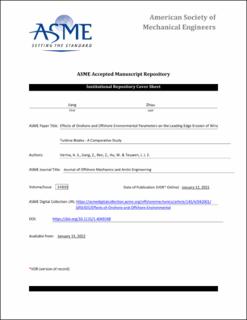| dc.contributor.author | Verma, Amrit Shankar | |
| dc.contributor.author | Jiang, Zhiyu | |
| dc.contributor.author | Ren, Zhengru | |
| dc.contributor.author | Hu, Weifei | |
| dc.contributor.author | Teuwen, Julie J.E. | |
| dc.date.accessioned | 2021-05-06T11:02:27Z | |
| dc.date.available | 2021-05-06T11:02:27Z | |
| dc.date.created | 2020-12-13T00:20:41Z | |
| dc.date.issued | 2021 | |
| dc.identifier.citation | Verma, A. S., Jiang, Z., Ren, Z., Hu, W. & Teuwen, J. J. E. (2020). Effects of Onshore and Offshore Environmental Parameters on the Leading Edge Erosion of Wind Turbine Blades : A Comparative Study. Journal of Offshore Mechanics and Arctic Engineering, 143(4): 042001. doi: | en_US |
| dc.identifier.issn | 0892-7219 | |
| dc.identifier.uri | https://hdl.handle.net/11250/2753918 | |
| dc.description | Author's accepted manuscript. | en_US |
| dc.description | Available from 13/01/2022. | |
| dc.description.abstract | The presence of rain-induced leading edge erosion of wind turbine blades necessitates the development of erosion models. One of the essential parameters for erosion modelling is the relative impact velocity between rain droplets and the rotating blade. Based on this parameter, the erosion damage rate of a wind turbine blade is calculated to estimate the expected leading edge lifetime. The environmental conditions that govern this parameter have site-specific variations, and thus, rain and wind loading on a turbine differ for onshore and offshore locations. In addition, there are wave loads present in the offshore environment. The present paper tries to provide guidelines for erosion modelling and investigates whether there are differences in erosion of blades due to (1) varying rainfall conditions modelled using different droplet size distributions for onshore and offshore locations in combination with (2) winds of varying turbulence intensities and (3) wave-induced loads. Aero-hydro-servo-elastic simulations are carried out for an onshore wind turbine and a monopile-supported offshore wind turbine. Furthermore, erosion variables such as the relative impact velocities and the associated erosion damage rate of a blade are analysed for various blade azimuth angles. The study shows that the rainfall intensity and turbulence intensity minorly influence the impact velocity and pressure but have a substantial effect on the overall erosion damage rate. Additionally, a significantly higher erosion damage rate is found for blades exposed to offshore rainfall conditions than for blades under onshore rainfall conditions. Furthermore, no substantial influence on erosion is found because of wave-induced loads. | en_US |
| dc.language.iso | eng | en_US |
| dc.publisher | American Society of Mechanical Engineers | en_US |
| dc.rights | Navngivelse 4.0 Internasjonal | * |
| dc.title | Effects of Onshore and Offshore Environmental Parameters on the Leading Edge Erosion of Wind Turbine Blades : A Comparative Study | en_US |
| dc.type | Journal article | en_US |
| dc.type | Peer reviewed | en_US |
| dc.description.version | acceptedVersion | en_US |
| dc.rights.holder | © 2021 American Society of Mechanical Engineers | en_US |
| dc.subject.nsi | VDP::Teknologi: 500 | en_US |
| dc.source.pagenumber | 15 | en_US |
| dc.source.volume | 143 | en_US |
| dc.source.journal | Journal of Offshore Mechanics and Arctic Engineering | en_US |
| dc.source.issue | 4 | en_US |
| dc.identifier.doi | 10.1115/1.4049248 | |
| dc.identifier.cristin | 1859132 | |
| dc.source.articlenumber | 042001 | en_US |
| cristin.qualitycode | 2 | |
